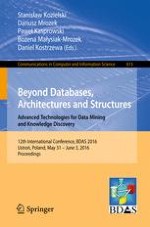2016 | Buch
Beyond Databases, Architectures and Structures. Advanced Technologies for Data Mining and Knowledge Discovery
12th International Conference, BDAS 2016, Ustroń, Poland, May 31 - June 3, 2016, Proceedings
herausgegeben von: Stanisław Kozielski, Dariusz Mrozek, Paweł Kasprowski, Bożena Małysiak-Mrozek, Daniel Kostrzewa
Verlag: Springer International Publishing
Buchreihe : Communications in Computer and Information Science
